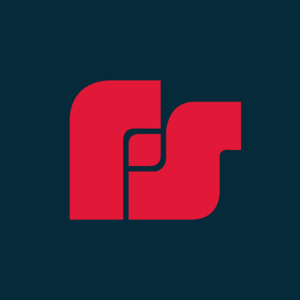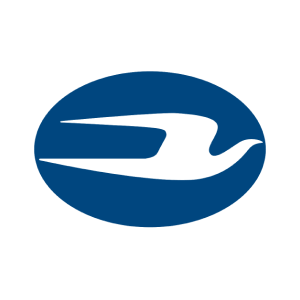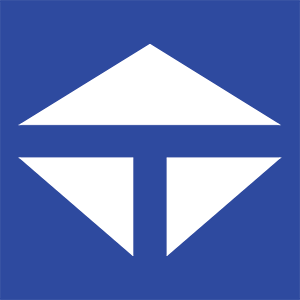
Greenbrier (GBX)
We’re skeptical of Greenbrier. Its sales have underperformed and its low returns on capital show it has few growth opportunities.― StockStory Analyst Team
1. News
2. Summary
Why We Think Greenbrier Will Underperform
Having designed the industry’s first double-decker railcar in the 1980s, Greenbrier (NYSE:GBX) supplies the freight rail transportation industry with railcars and related services.
- Forecasted revenue decline of 8.6% for the upcoming 12 months implies demand will fall even further
- Competitive supply chain dynamics and steep production costs are reflected in its low gross margin of 13.9%
- A consolation is that its performance over the past five years shows its incremental sales were extremely profitable, as its annual earnings per share growth of 33.9% outpaced its revenue gains


Greenbrier doesn’t live up to our standards. We see more lucrative opportunities elsewhere.
Why There Are Better Opportunities Than Greenbrier
High Quality
Investable
Underperform
Why There Are Better Opportunities Than Greenbrier
Greenbrier is trading at $46.46 per share, or 11.5x forward P/E. This multiple is cheaper than most industrials peers, but we think this is justified.
Our advice is to pay up for elite businesses whose advantages are tailwinds to earnings growth. Don’t get sucked into lower-quality businesses just because they seem like bargains. These mediocre businesses often never achieve a higher multiple as hoped, a phenomenon known as a “value trap”.
3. Greenbrier (GBX) Research Report: Q3 CY2025 Update
Rail transportation company Greenbrier (NYSE:GBX) fell short of the market’s revenue expectations in Q3 CY2025, with sales falling 27.9% year on year to $759.5 million. The company’s full-year revenue guidance of $2.95 billion at the midpoint came in 6.5% below analysts’ estimates. Its GAAP profit of $1.16 per share was 1.7% below analysts’ consensus estimates.
Greenbrier (GBX) Q3 CY2025 Highlights:
- Revenue: $759.5 million vs analyst estimates of $764.1 million (27.9% year-on-year decline, 0.6% miss)
- EPS (GAAP): $1.16 vs analyst expectations of $1.18 (1.7% miss)
- Adjusted EBITDA: $115 million vs analyst estimates of $105.2 million (15.1% margin, 9.3% beat)
- EPS (GAAP) guidance for the upcoming financial year 2026 is $4.25 at the midpoint, missing analyst estimates by 14.6%
- Operating Margin: 9.5%, down from 11.8% in the same quarter last year
- Free Cash Flow Margin: 3.5%, down from 11.2% in the same quarter last year
- Sales Volumes fell 45.5% year on year (-71.2% in the same quarter last year)
- Market Capitalization: $1.41 billion
Company Overview
Having designed the industry’s first double-decker railcar in the 1980s, Greenbrier (NYSE:GBX) supplies the freight rail transportation industry with railcars and related services.
Its product offerings include various types of railcars used for bulk transportation of goods. Greenbrier's hopper cars are used to move commodities like grain and coal, and its tank cars are used to move oil and chemicals, for example. Boxcars, flat cars, gondolas, and autorack cars round out its offerings and are all used for specific end markets.
Greenbrier designs, manufactures, and assembles these various types of railcars for its customers, who are major freight railroad operators and other commercial businesses that require long-haul transportation of goods. It generates revenue through the sale of these products, mostly made through direct sales. Greenbrier also generates more predictable and recurring revenue through the leasing of these products, where the customer doesn't take ownership and where Greenbrier may include various maintenance services. In addition to maintenance, the company's service offerings include repair and management services like making sure its clients’ cars comply with regulations.
Like many industries, Greenbrier is investing in digitization, which can help better track goods and predict transit times. Digitization also improves the data that customers may need to reduce transportation expenses and emissions. It is another vector in addition to service and price that satisfies customers and keeps them coming back.
4. Heavy Transportation Equipment
Heavy transportation equipment companies are investing in automated vehicles that increase efficiencies and connected machinery that collects actionable data. Some are also developing electric vehicles and mobility solutions to address customers’ concerns about carbon emissions, creating new sales opportunities. Additionally, they are increasingly offering automated equipment that increases efficiencies and connected machinery that collects actionable data. On the other hand, heavy transportation equipment companies are at the whim of economic cycles. Interest rates, for example, can greatly impact the construction and transport volumes that drive demand for these companies’ offerings.
Competitors of Greenbrier include Trinity (NYSE:TRN), FreightCar America (NASDAQ:RAIL), and private company American Railcar Industries (which was acquired by ITE Management).
5. Revenue Growth
A company’s long-term sales performance can indicate its overall quality. Any business can put up a good quarter or two, but many enduring ones grow for years. Unfortunately, Greenbrier’s 3% annualized revenue growth over the last five years was sluggish. This was below our standard for the industrials sector and is a poor baseline for our analysis.
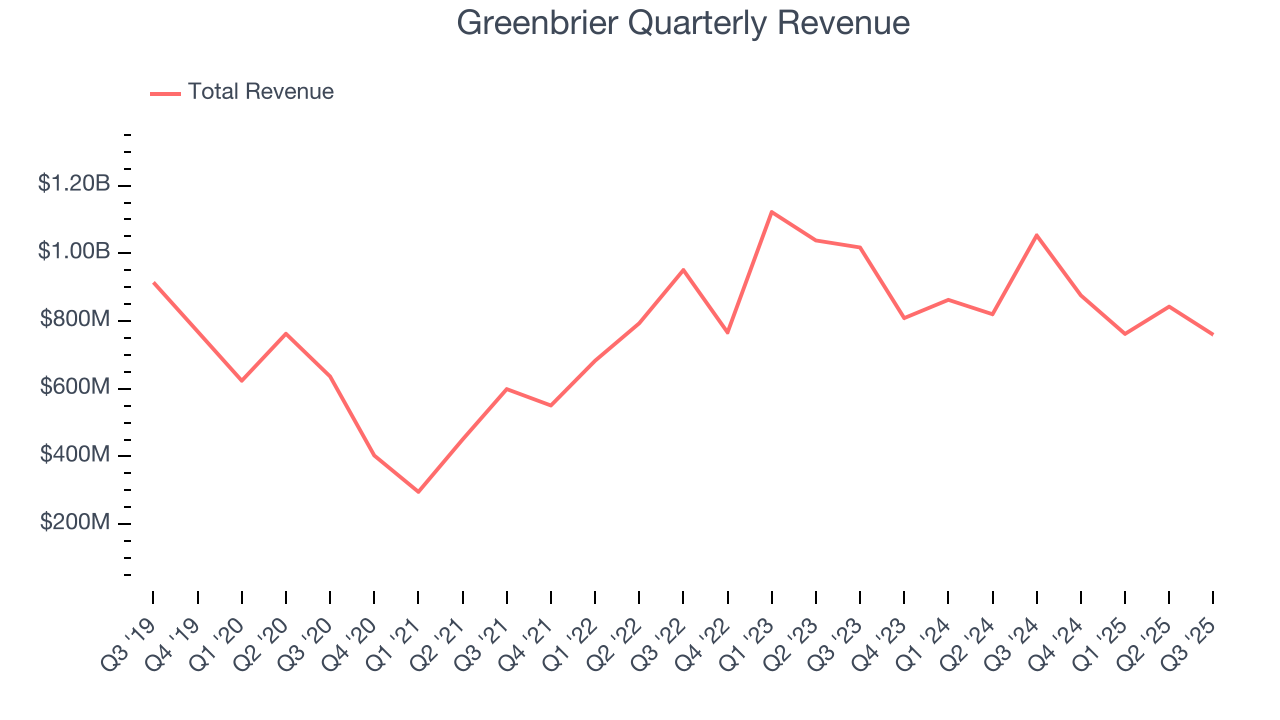
We at StockStory place the most emphasis on long-term growth, but within industrials, a half-decade historical view may miss cycles, industry trends, or a company capitalizing on catalysts such as a new contract win or a successful product line. Greenbrier’s performance shows it grew in the past but relinquished its gains over the last two years, as its revenue fell by 9.4% annually. Greenbrier isn’t alone in its struggles as the Heavy Transportation Equipment industry experienced a cyclical downturn, with many similar businesses observing lower sales at this time. 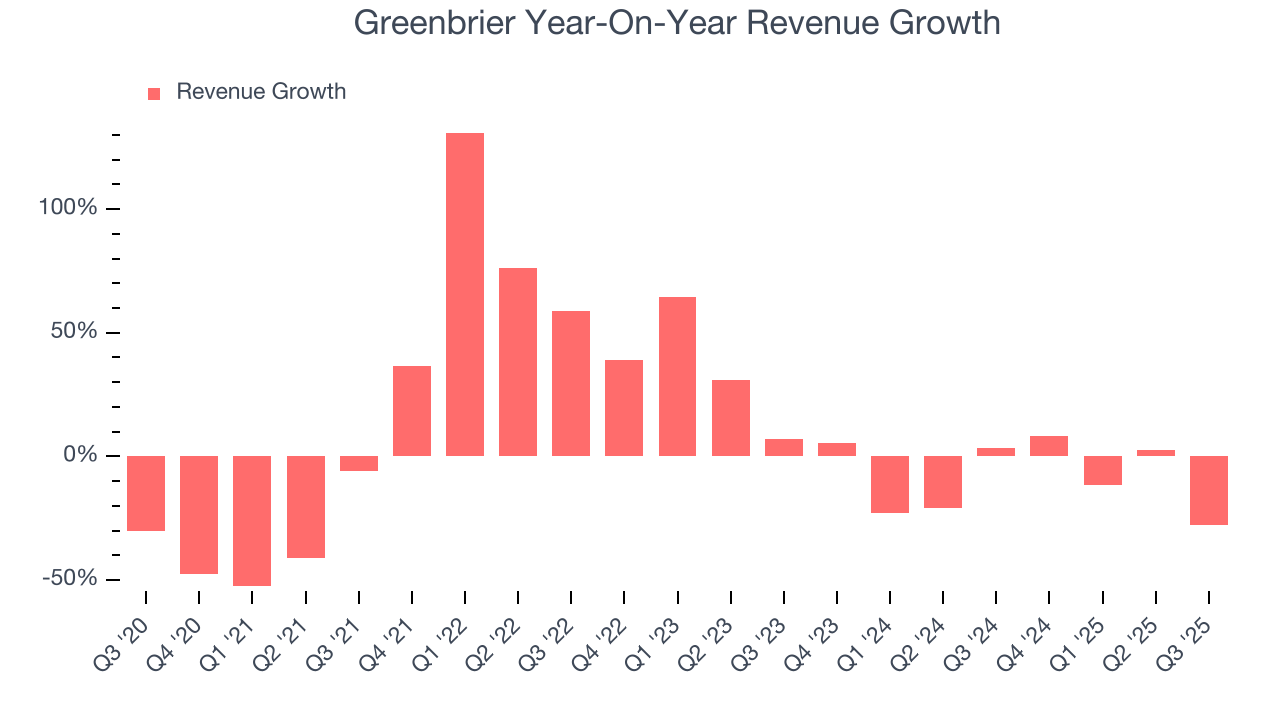
Greenbrier also reports its number of units sold, which reached 2,400 in the latest quarter. Over the last two years, Greenbrier’s units sold averaged 21.1% year-on-year declines. Because this number is lower than its revenue growth, we can see the company benefited from price increases. 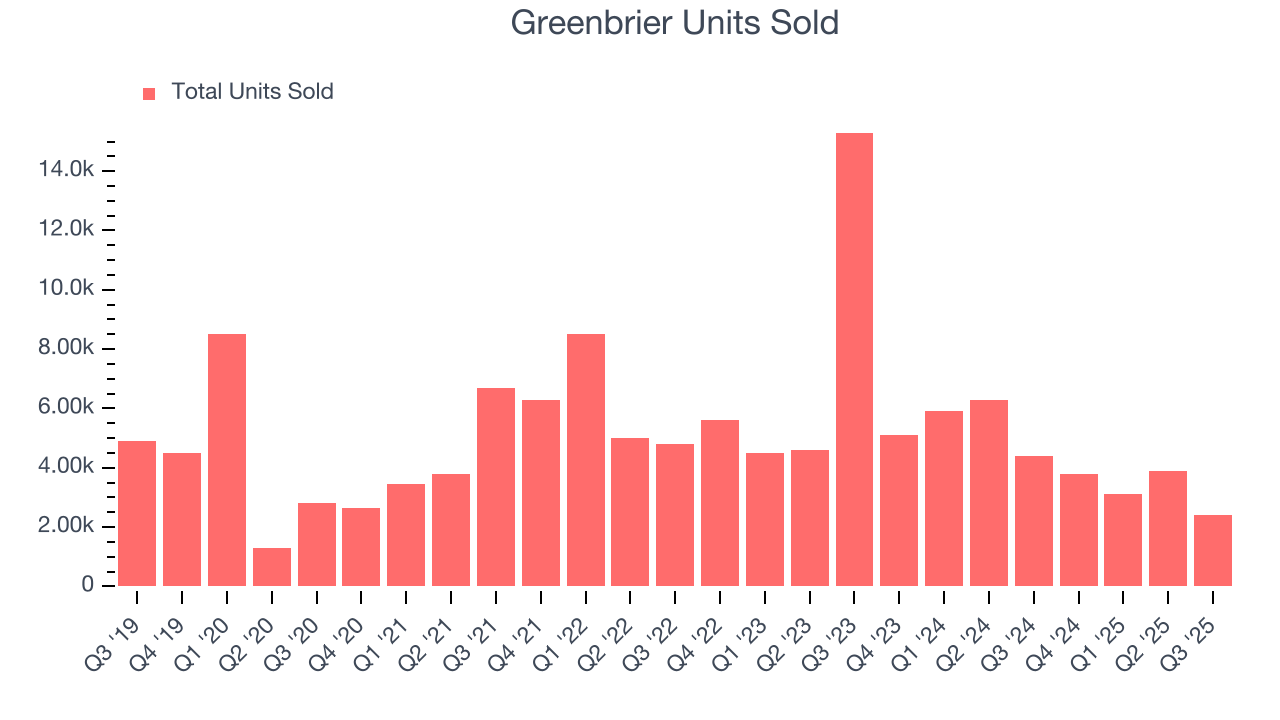
This quarter, Greenbrier missed Wall Street’s estimates and reported a rather uninspiring 27.9% year-on-year revenue decline, generating $759.5 million of revenue.
Looking ahead, sell-side analysts expect revenue to grow 1.5% over the next 12 months. Although this projection implies its newer products and services will spur better top-line performance, it is still below the sector average.
6. Gross Margin & Pricing Power
All else equal, we prefer higher gross margins because they make it easier to generate more operating profits and indicate that a company commands pricing power by offering more differentiated products.
Greenbrier has bad unit economics for an industrials business, signaling it operates in a competitive market. As you can see below, it averaged a 13.9% gross margin over the last five years. That means Greenbrier paid its suppliers a lot of money ($86.12 for every $100 in revenue) to run its business. 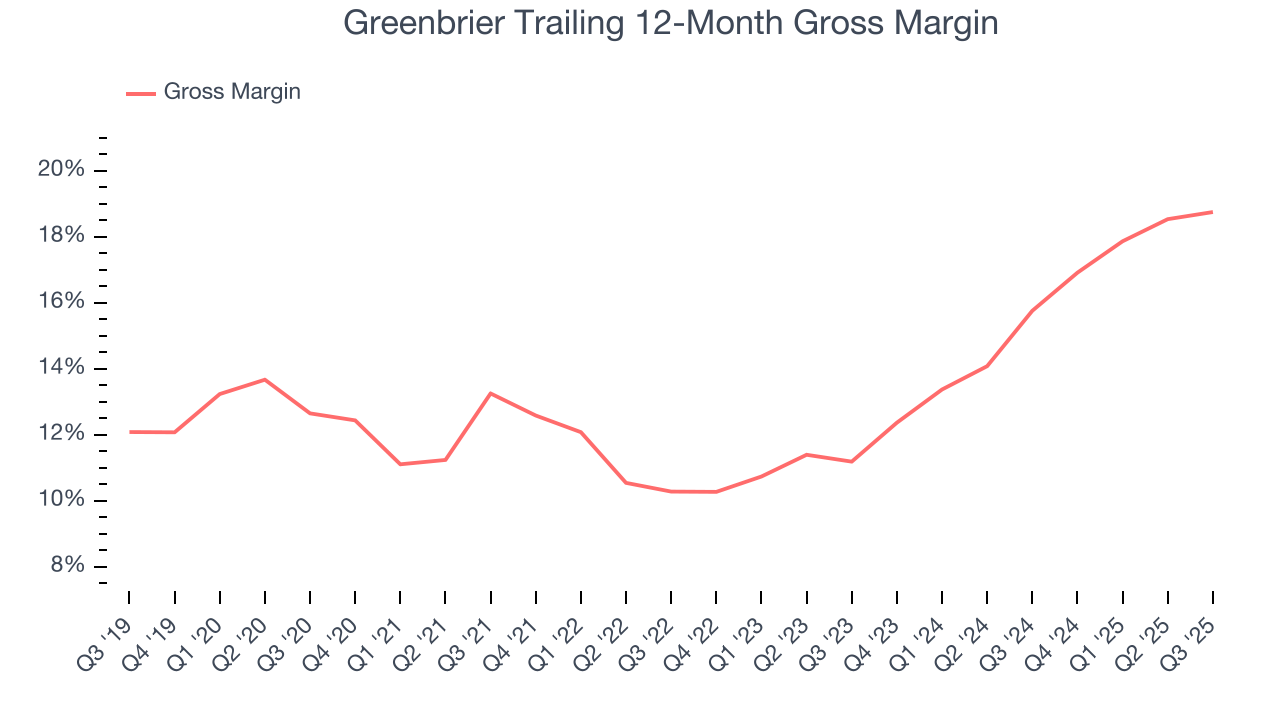
This quarter, Greenbrier’s gross profit margin was 18.9%, in line with the same quarter last year. Zooming out, Greenbrier’s full-year margin has been trending up over the past 12 months, increasing by 3 percentage points. If this move continues, it could suggest better unit economics due to some combination of stable to improving pricing power and input costs (such as raw materials).
7. Operating Margin
Greenbrier was profitable over the last five years but held back by its large cost base. Its average operating margin of 6.6% was weak for an industrials business. This result isn’t too surprising given its low gross margin as a starting point.
On the plus side, Greenbrier’s operating margin rose by 8.8 percentage points over the last five years, as its sales growth gave it operating leverage.
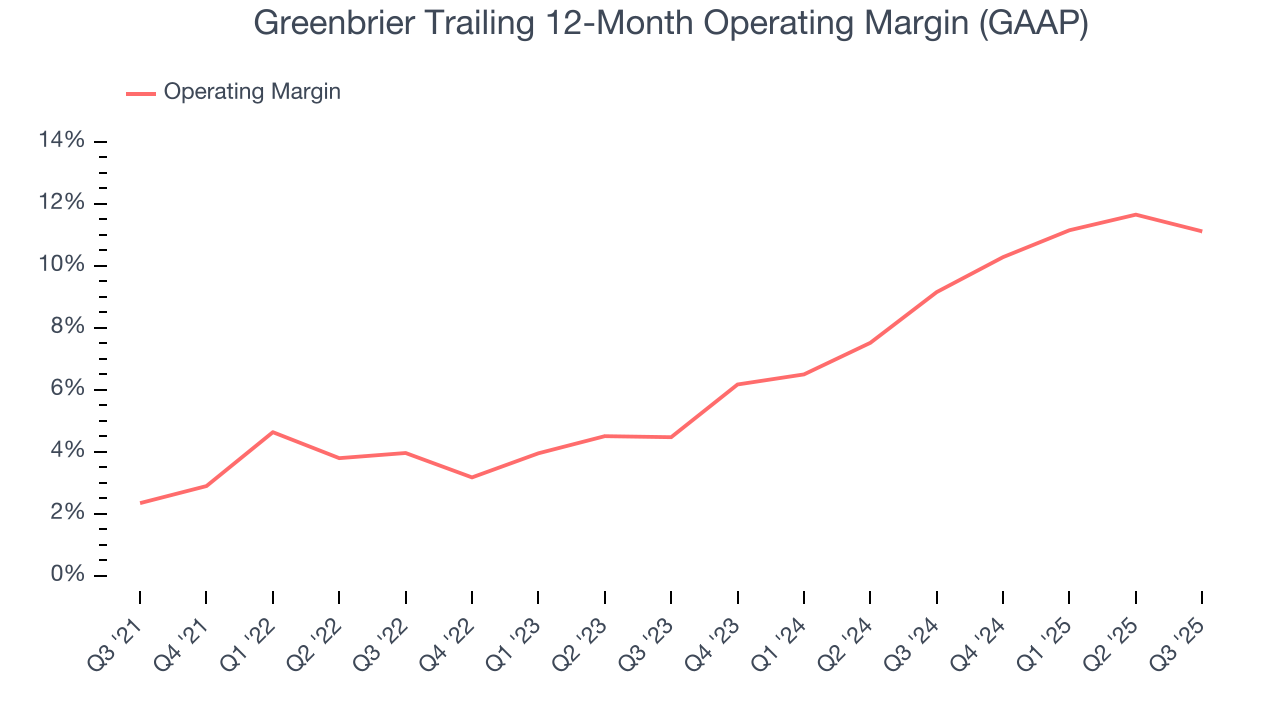
This quarter, Greenbrier generated an operating margin profit margin of 9.5%, down 2.3 percentage points year on year. Since Greenbrier’s operating margin decreased more than its gross margin, we can assume it was less efficient because expenses such as marketing, R&D, and administrative overhead increased.
8. Earnings Per Share
Revenue trends explain a company’s historical growth, but the long-term change in earnings per share (EPS) points to the profitability of that growth – for example, a company could inflate its sales through excessive spending on advertising and promotions.
Greenbrier’s EPS grew at an astounding 33.9% compounded annual growth rate over the last five years, higher than its 3% annualized revenue growth. This tells us the company became more profitable on a per-share basis as it expanded.
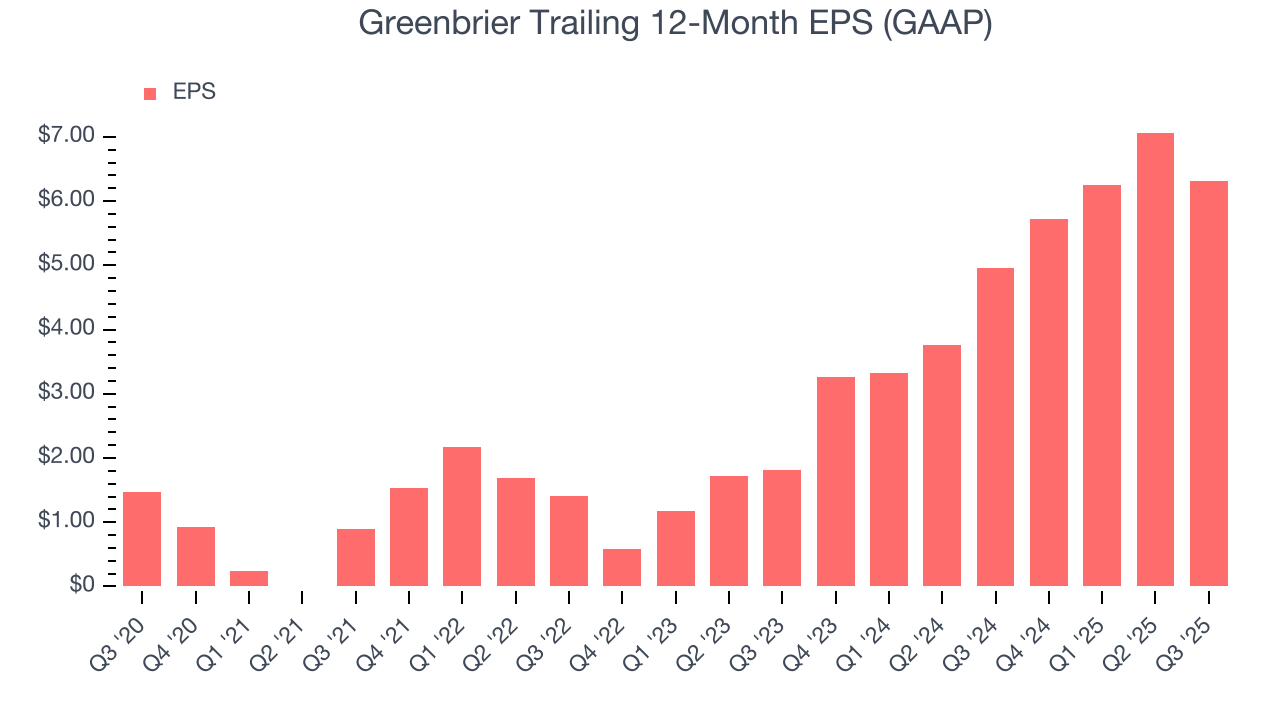
We can take a deeper look into Greenbrier’s earnings to better understand the drivers of its performance. As we mentioned earlier, Greenbrier’s operating margin declined this quarter but expanded by 8.8 percentage points over the last five years. Its share count also shrank by 1.6%, and these factors together are positive signs for shareholders because improving profitability and share buybacks turbocharge EPS growth relative to revenue growth. 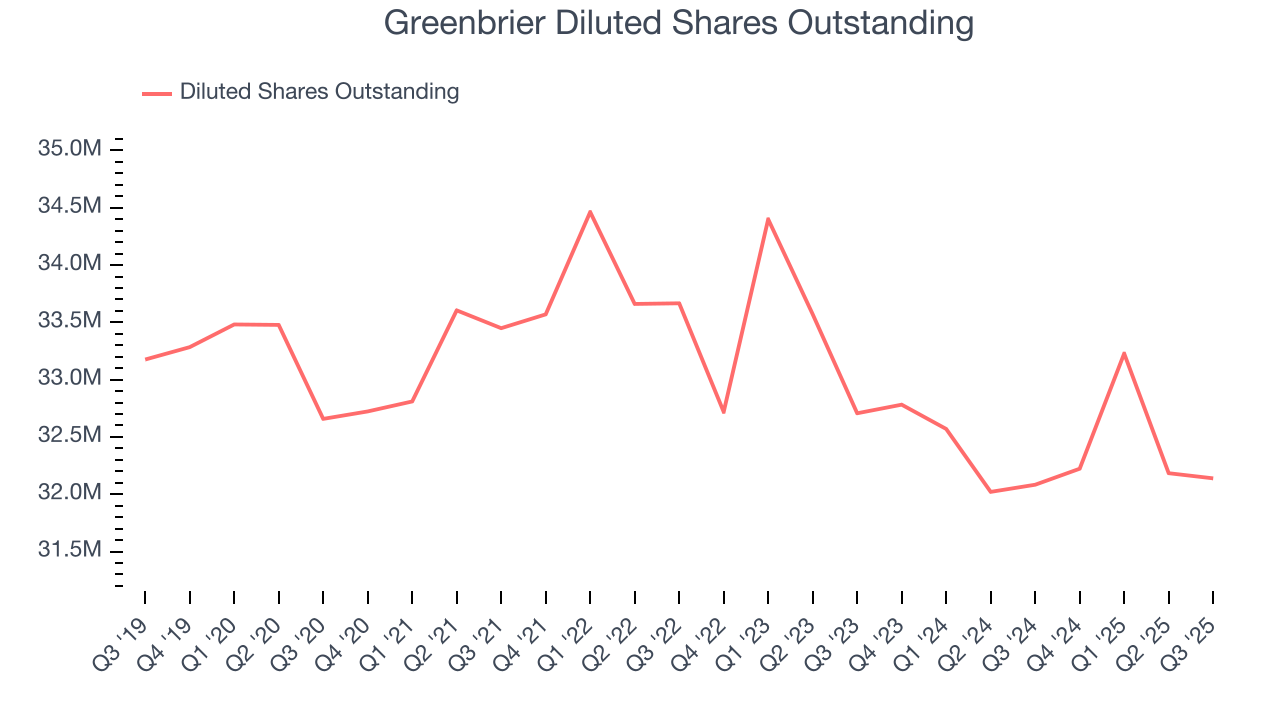
Like with revenue, we analyze EPS over a more recent period because it can provide insight into an emerging theme or development for the business.
For Greenbrier, its two-year annual EPS growth of 86.1% was higher than its five-year trend. We love it when earnings growth accelerates, especially when it accelerates off an already high base.
In Q3, Greenbrier reported EPS of $1.16, down from $1.92 in the same quarter last year. This print slightly missed analysts’ estimates, but we care more about long-term EPS growth than short-term movements. We also like to analyze expected EPS growth based on Wall Street analysts’ consensus projections, but there is insufficient data.
9. Cash Is King
Although earnings are undoubtedly valuable for assessing company performance, we believe cash is king because you can’t use accounting profits to pay the bills.
While Greenbrier posted positive free cash flow this quarter, the broader story hasn’t been so clean. Greenbrier’s demanding reinvestments have drained its resources over the last five years, putting it in a pinch and limiting its ability to return capital to investors. Its free cash flow margin averaged negative 7%, meaning it lit $7.02 of cash on fire for every $100 in revenue.
Taking a step back, an encouraging sign is that Greenbrier’s margin expanded by 9.8 percentage points during that time. Despite its improvement and recent free cash flow generation, we’d like to see more quarters of positive cash flow before recommending the stock.
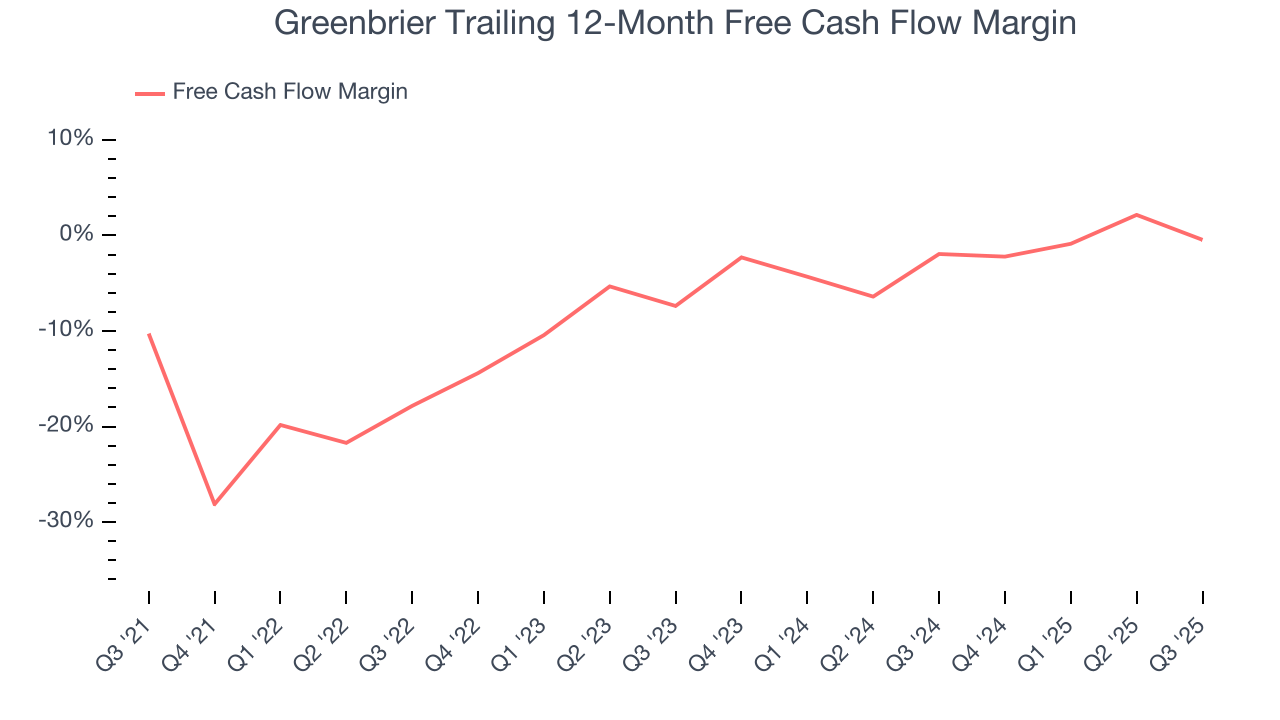
Greenbrier’s free cash flow clocked in at $26.7 million in Q3, equivalent to a 3.5% margin. The company’s cash profitability regressed as it was 7.7 percentage points lower than in the same quarter last year, but it’s still above its five-year average. We wouldn’t read too much into this quarter’s decline because investment needs can be seasonal, leading to short-term swings. Long-term trends trump temporary fluctuations.
10. Return on Invested Capital (ROIC)
EPS and free cash flow tell us whether a company was profitable while growing its revenue. But was it capital-efficient? A company’s ROIC explains this by showing how much operating profit it makes compared to the money it has raised (debt and equity).
Greenbrier historically did a mediocre job investing in profitable growth initiatives. Its five-year average ROIC was 6.9%, somewhat low compared to the best industrials companies that consistently pump out 20%+.
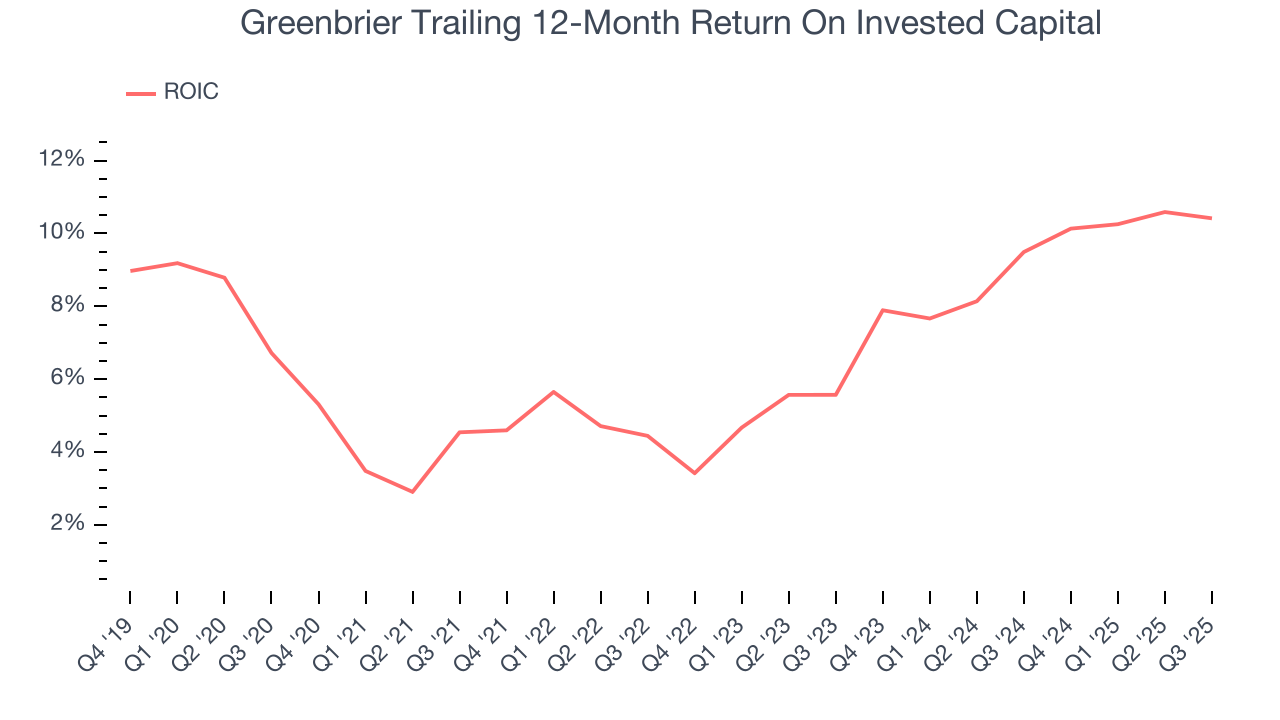
We like to invest in businesses with high returns, but the trend in a company’s ROIC is what often surprises the market and moves the stock price. Fortunately, Greenbrier’s has increased over the last few years. This is a good sign, and we hope the company can continue improving.
11. Balance Sheet Assessment
Greenbrier reported $306.1 million of cash and $1.75 billion of debt on its balance sheet in the most recent quarter. As investors in high-quality companies, we primarily focus on two things: 1) that a company’s debt level isn’t too high and 2) that its interest payments are not excessively burdening the business.
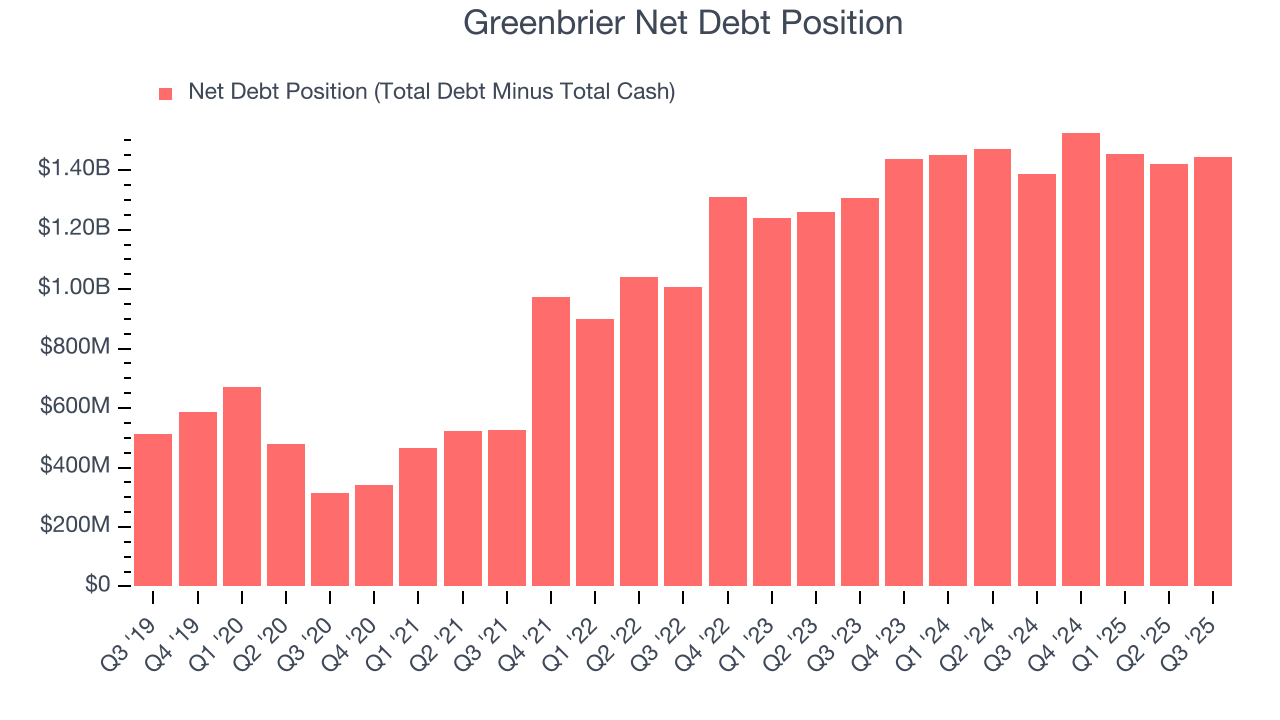
With $498.9 million of EBITDA over the last 12 months, we view Greenbrier’s 2.9× net-debt-to-EBITDA ratio as safe. We also see its $41.8 million of annual interest expenses as appropriate. The company’s profits give it plenty of breathing room, allowing it to continue investing in growth initiatives.
12. Key Takeaways from Greenbrier’s Q3 Results
We were impressed by how significantly Greenbrier blew past analysts’ EBITDA expectations this quarter. On the other hand, its revenue, EPS, and full-year guidance for both metrics missed. Overall, this was a softer quarter. The stock traded down 6% to $42.54 immediately following the results.
13. Is Now The Time To Buy Greenbrier?
Updated: December 24, 2025 at 10:29 PM EST
The latest quarterly earnings matters, sure, but we actually think longer-term fundamentals and valuation matter more. Investors should consider all these pieces before deciding whether or not to invest in Greenbrier.
Greenbrier’s business quality ultimately falls short of our standards. To begin with, its revenue growth was weak over the last five years, and analysts expect its demand to deteriorate over the next 12 months. And while its rising cash profitability gives it more optionality, the downside is its projected EPS for the next year is lacking. On top of that, its cash burn raises the question of whether it can sustainably maintain growth.
Greenbrier’s P/E ratio based on the next 12 months is 11.5x. This valuation multiple is fair, but we don’t have much faith in the company. We're fairly confident there are better investments elsewhere.
Wall Street analysts have a consensus one-year price target of $43.67 on the company (compared to the current share price of $46.46).






